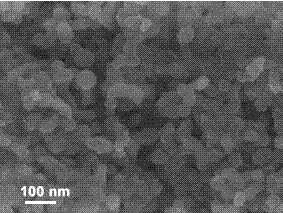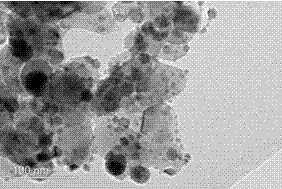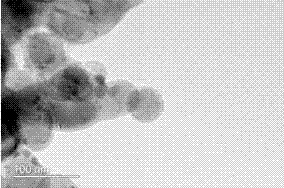Si@C lithium-ion battery negative electrode material of core-shell structure and preparation method thereof
A lithium-ion battery, core-shell structure technology, applied in the direction of battery electrodes, secondary batteries, structural parts, etc., can solve the problem that it is difficult to produce a carbon coating layer with a pore structure, it is difficult to achieve large-scale production, and there are few reports on modification, etc. problems, to achieve the effect of being suitable for large-scale production, good product consistency, and improving rate performance and cycle performance
- Summary
- Abstract
- Description
- Claims
- Application Information
AI Technical Summary
Problems solved by technology
Method used
Image
Examples
Embodiment 1
[0032] A. Surface activation of nano-silicon: First, ultrasonically disperse 200 mg of spherical nano-silicon with a diameter of 50-70 nm into 40 ml of 30wt% H 2 o 2 Medium, and the ultrasonic power is 100W, and the time is 20min.
[0033] Then stir at room temperature for 0.5 h to fully activate the spherical nano-silicon.
[0034] After filtering, the filtered product was washed three times with deionized water and absolute ethanol respectively, and then vacuum-dried for 12 hours at a vacuum degree of 0.05 MPa and 55° C. to obtain activated nano-silicon.
[0035]B. Preparation of Si@ZIF-67 precursor: Weigh 20 mg of the above-mentioned activated nano-silicon, ultrasonically disperse it into 60 mL of a mixed solution of methanol and ethanol with a volume ratio of 1:1, add 0.2 g of polyvinylpyrrolidone and 0.07 g of hexahydrate Cobalt nitrate, and continued ultrasonic stirring for 1 h to obtain a suspension.
[0036] Then, because the precursor of Si@ZIF-67 can be generated ...
Embodiment 2
[0041] A. Surface activation of nano-silicon: First, ultrasonically disperse 200mg of spherical nano-silicon with a diameter of 50-70nm into 40 ml of 30wt% H 2 o 2 Medium, and the ultrasonic power is 100W, and the time is 2min.
[0042] Then stir at room temperature for 3 h to fully activate the spherical nano-silicon.
[0043] After filtering, the filtered product was washed three times with deionized water and absolute ethanol respectively, and then vacuum-dried for 10 hours at a vacuum degree of 0.1 MPa and 60° C. to obtain activated nano-silicon.
[0044] B. Preparation of Si@ZIF-67 precursor: Weigh 20 mg of the above-mentioned activated nano-silicon, ultrasonically disperse it into 60 mL of a mixed solution of ethanol and methanol mixed at a volume ratio of 1:2, add 0.2 g polyvinylpyrrolidone and 0.5 g Cobalt chloride hexahydrate, continue ultrasonic stirring for 3 h to obtain a suspension.
[0045] Then take by weighing 0.342g 2-methylimidazole and be dissolved in 60m...
Embodiment 3
[0051] A. Surface activation of nano-silicon: first disperse 150mg of spherical nano-silicon with a diameter of 50-70nm into 40ml of 30wt% H 2 o 2 Medium, and the ultrasonic power is 100W, and the time is 10min.
[0052] Then stir at room temperature for 3 h to fully activate the spherical nano-silicon.
[0053] After filtering, the filtered product was washed three times with deionized water and absolute ethanol respectively, and then vacuum-dried for 10 hours at a vacuum degree of 0.1 MPa and 60° C. to obtain activated nano-silicon.
[0054] B. Preparation of Si@MIL-88(Fe) precursor: Weigh 20 mg of the above-mentioned activated nano-silicon, ultrasonically disperse it into 60 mL of a mixed solution of ethanol and dimethylformamide mixed at a volume ratio of 1:1, add 0.025 g ferric nitrate nonahydrate, and continue ultrasonic stirring for 2 h. Then add 0.018g of terephthalic acid, continue to stir for 0.5h, transfer the resulting solution to the reactor, and keep it warm f...
PUM
| Property | Measurement | Unit |
|---|---|---|
| diameter | aaaaa | aaaaa |
| thickness | aaaaa | aaaaa |
Abstract
Description
Claims
Application Information
 Login to View More
Login to View More - R&D
- Intellectual Property
- Life Sciences
- Materials
- Tech Scout
- Unparalleled Data Quality
- Higher Quality Content
- 60% Fewer Hallucinations
Browse by: Latest US Patents, China's latest patents, Technical Efficacy Thesaurus, Application Domain, Technology Topic, Popular Technical Reports.
© 2025 PatSnap. All rights reserved.Legal|Privacy policy|Modern Slavery Act Transparency Statement|Sitemap|About US| Contact US: help@patsnap.com



